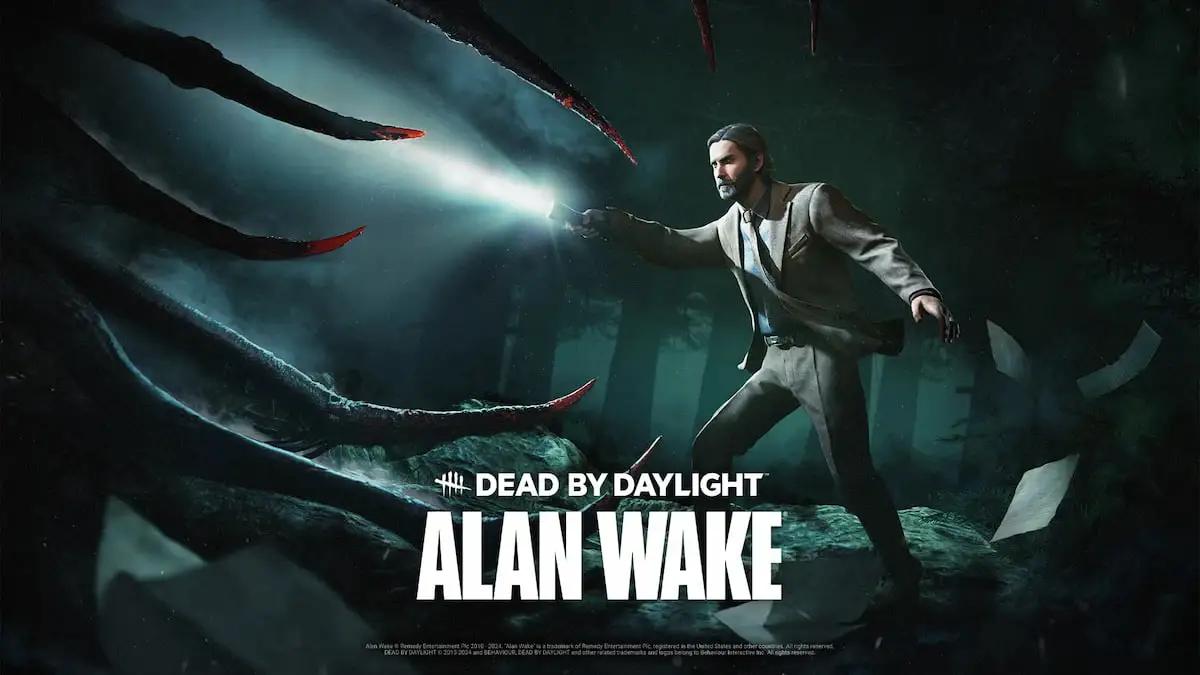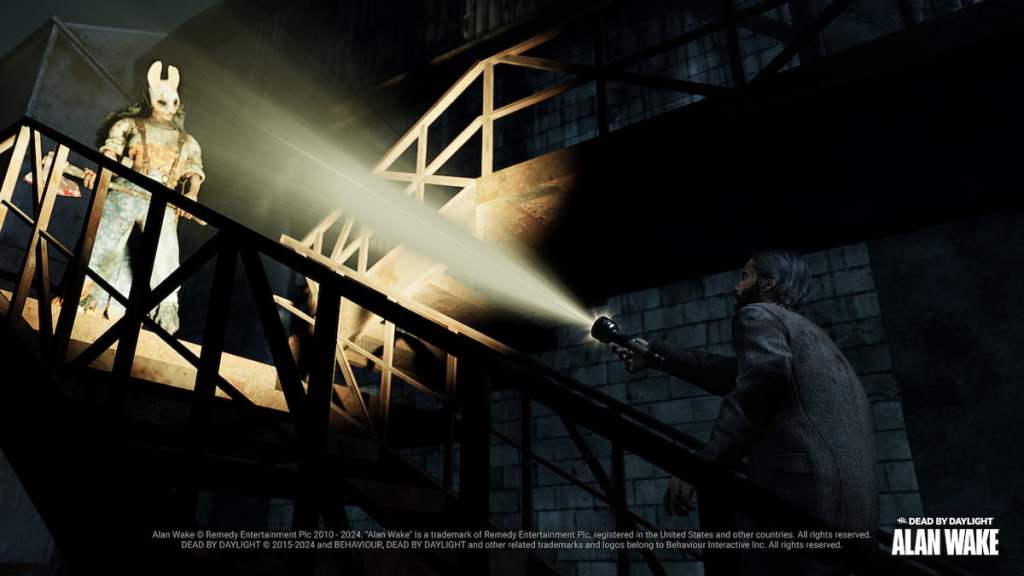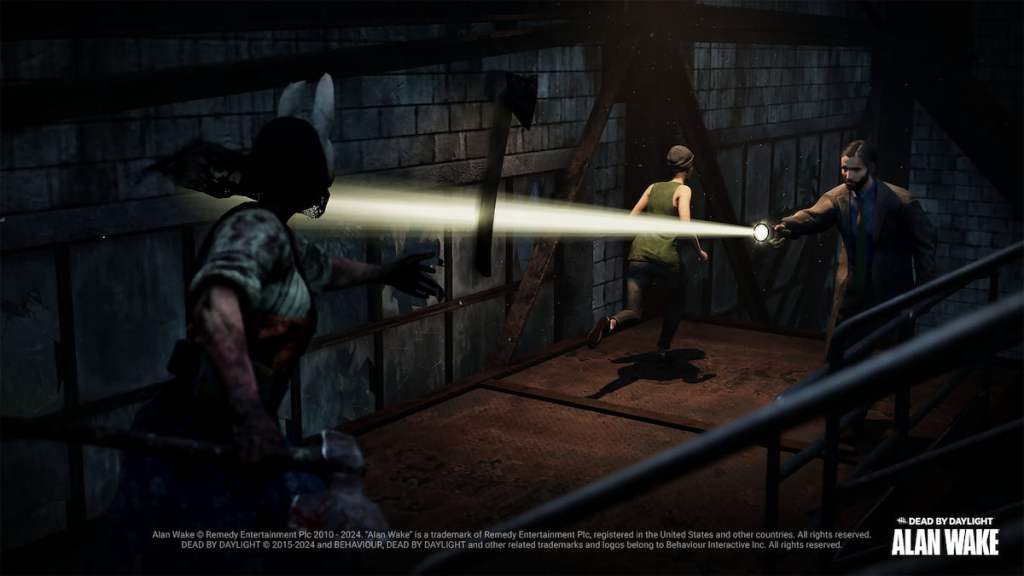
The concept of survival horror, at its roots, is to pit the player against an overwhelming force and give them limited tools to overcome it. It’s a brutal fight that can take many forms, and Behaviour Interactive’s Dead by Daylight is vastly different from Remedy Entertainment’s Alan Wake 2. However, these two studios have plenty of common ground with one another, which makes Alan’s arrival to the unnerving fog a natural fit. As Alan Wake finds himself in a game with a macabre of horror icons and Behaviour Interactive originals, he faces the ultimate challenge to see if he has what it takes to survive alongside a team.
We had the chance to sit down in a group discussion with Behavior Interactive’s senior creative director, Dave Richard, and Remedy Entertainment’s game director, Kyle Rowley. They went back and forth, discussing the driving forces behind their distinct survival horror games and the unique topics their teams regularly discuss to bring about these iconic experiences.
The Love for Cosmic Horror & Fear of the Uncertainty
When you put Alan Wake 2 alongside Dead by Daylight, these two are different experiences. Alan Wake 2 has a distinct narrative, where players have limited resources and have to solve time-sensitive puzzles before being overrun by enemies. Dead by Daylight has players becoming the Survivor or Killer, where one attempts to escape, and the other hunts the others down before they can leave. Although these two are different, they share one important connection: An unknown, cosmic enemy. For Alan Wake 2, it’s the Dark Presence, and Dead by Daylight has the Entity.
Neither cosmic enemies have a set understanding, either, and this is entirely intended by the team. Richard said, “The thing important for us is that when we created this universe, we were as ambiguous as possible. There is no definite truth. We want to leave a lot of the theory building to our fans.”
Rowley offered similar thoughts on how Remedy tackles the Dark Presence. “There are little connection points between your universe and ours in Alan Wake. We have this Dark Place, a nightmare reality that’s creating nightmare fiction based on the people who inhabit it. It’s taking all the experiences and mental thoughts that Alan has had throughout his life and conjuring it as a nightmare. It’s similar to the concepts you [Behaviour] have with the Entity realm in Dead by Daylight.”
Both teams shared that they love to create these ambiguities to give players agency over the threats they face. They want to make sure they’re not answering the question of identifying what that scary, horrible thing is in the dark and allow players to let their imagination run wild. Richard detailed that, internally, the Behaviour team also does not have a clear answer to this question about what the Entity is, which might be why they also avoid the answer to fans. The same goes for the Remedy team and what exactly the Dark Presence could be.
“To the developers on our team [Remedy] are like, ‘Goddammit, I wish I knew. Just tell us what it actually is so we can figure it out,’” Rowley detailed. “When I’m talking with Sam [Lake], and I’m trying to have these conversations. We don’t actually know. We leave that open. I think Sam has an idea in the back of his head but doesn’t quite want to reveal it. Ultimately, there’s no discovery if we know the answer before we make it. I think a lot of our games are about the discovery of making the game. We try not to have everything answered on paper.”
The fear of the unknown drives against the protagonists as they face off against the major antagonists in Dead by Daylight and Alan Wake 2. It’s a basic human instinct to fear the dark and what could be within it while serving as a potential to discover the unknown, which is perfect for horror storytellers. The similarities between these two games also made it so Alan could have a seamless pivot into Dead by Daylight, but the way he got there is a true mystery, even to the Behaviour team.
“There’s a concept in DbD where, because it’s a multiverse and the Entity can break through holes through different timelines, that some people, especially artists, can be conduits to other universes, ” Richard said. “Seeing Alan also has the power to conjure his writing into reality made it a chicken and egg problem. It made it very easy to integrate. Is it Alan writing the reality of the Entity? Is it the Entity’s realm poking a hole in the Dark Presence and getting Alan Wake. What exactly is happening is out for theory, and we’ll let the fans decide.”
Rowley got a laugh out of this because that’s what he and the Remedy team frequently do with many of their titles. The underlying fear of what drives humans to cower away from the unknown makes it a great enemy, and both teams have fun playing with it, as providing a truthful answer could easily take away this unsettling feeling and magic the teams have developed with their fans.
What’s also interesting is how Remedy and Behaviour tackle survival horror. Even though Alan Wake 2 and Dead by Daylight are distinctly different, there’s a relation between how players have to tackle threats and the recent rise to survival horror in the games industry, making it one of the best times to enjoy these titles.
The Resurgence of Survival Horror Games Benefits Everyone

Although the gameplay experiences of Alan Wake 2 and Dead by Daylight are vastly different, they are survival horror games at their core. They have design choices where the players question the reality of a particular situation and make split-second decisions based on minimal information to survive. Rowley and Richard reminisced that for the past few years, the rise in survival horror games has been fantastic for both of their games. For Remedy Entertainment, their knee-jerk intention was to make Alan Wake 2 a survival horror game, but after the definitive success of the Resident Evil 2 Remake, they knew they made the correct decision. Rowley had a lot of positive things to say when asked about the future of horror games.
“I’m personally super excited,” Rowley replied, “I think we’re in a really good spot. When we were originally doing the concept for Alan Wake 2, the Resident Evil 2 Remake had just come out. We [Remedy] talked about really wanting to do a survival horror game. At the time, they weren’t the most possible genre of game that was available. But after Resident Evil 2 Remake came out, everyone loved it, and it did very well commercially, it gave us the confidence that we could do what we wanted creatively, and the market is open to this. Since then, the market has only gotten better and better.”
“We love to see it, and I agree with you,” Richard said, “I think that horror takes more and more space. A lot of people have been saying that horror is niche. I don’t believe it is. I think everyone wants a little bit of horror in different styles, and it’s not what games have been offering.”
The continued success of the Resident Evil franchise is a perfect example of this, giving development studios who want to create a single-player, narrative horror experience the justification they need to move forward with it. Alan Wake 2 might not be the game it is today if Resident Evil 2 Remake had not done as well, alongside the unique experience from Dead by Daylight, hitting the correct note of multiplayer, co-op horror.
The answer to the success of horror games, though, is a much more complicated one. Alan Wake 2 drove this home by not offering the typical, cheap jump scare from seeing something scary but experiencing that feeling of uncertainty and the rush of not knowing what’s about to happen next. The same goes for Dead by Daylight, where, at the start of every match, the player has no idea what they’re about to face, and they have to drive forward, using the limited tools available to them to charge ahead and achieve victory.
These notable gameplay differences between Alan Wake 2 and Dead by Daylight make them fantastic. They share the same mission, and go about it uniquely, but this also presents distinct challenges to Remedy and Behaviour. At their core, how they address these issues is their way to remove player expectations and provide a memorable experience.
Dead by Daylight & Alan Wake 2 Developers Tackle Player Expectations

The player experience for Dead by Daylight vastly differs from Alan Wake 2, where matches can last anywhere from 10 to 20 minutes, and then you’re jumping back into the next one. If you’re playing Alan Wake 2, you’re there for the larger story, solving the intricate, game-spanning puzzles that can take you until you reach the credits to figure out. Not every question is answered correctly, and there’s still more to figure out.
Alan Wake 2 and Dead by Daylight share this concept of looping, but it’s handled differently. Alan is looping in the Dark Place and uses that to solve puzzles and try to escape. Players in Dead by Daylight are looping in much shorter intervals with their matches, picking and choosing their perks and tools to take with them against the next unknown Killer. In Alan Wake 2, this was tackled differently based on what character the player was using.
“On Saga’s side, the enemies are present, and they’re there with you,” Rowley said, “For Wake, It’s slightly more psychological, and he’s unsure of himself. He’s paranoid about what’s real. We built that into our horror experience. A lot of the emotional response from players on the Wake side is this paranoia of not knowing if something is real or not. That comes about for the fact he’s been there for so long, going through these loops over and over again.”
“On our side, the loop is not affecting our players, but the uncertainty is,” Richard replied, “The fear of the unknown is a core pillar of what DbD is. Every time you load into a match, you don’t know where you are, who you will face, what they’re going to be using, or their strategies. That is fear, or at least stress.”
“I feel that we have it the easy way,” Rowley continued, “We’re doing this one experience, where you play through it once or twice if you want to get the Final Draft, full experience. We’re controlling it a bit more. We can understand what the player have seen and what they’ve done before. We know where they are, and we can set things up. I feel like you guys [Behaviour] have it really hard, with the fact it’s all dynamic. It’s all player-driven. Trying to create those emotional responses from a horror-based game driven by players is a very interesting challenge; I think you guys have nailed it.”
Both Remedy and Behaviour have challenges to tackle to keep their players motivated, as well as challenges in how they handle uncertainty. Even though they’re both horror styles, how they manifest those emotions with their players is enriching to see these two routes.
The success of these games can only benefit the horror gaming genre moving forward, and bringing these two communities together is wonderful. It makes having Alan Wake enter Dead by Daylight’s fog that much more enriching, as he finds himself bringing a distinct set of skills to help battle the cosmic Entity. Getting to sit down with Rowley and Richard was an exciting opportunity, and I’m ecstatic to jump into my next Dead by Daylight match as Alan Wake to become the Champion of Light in the fog.